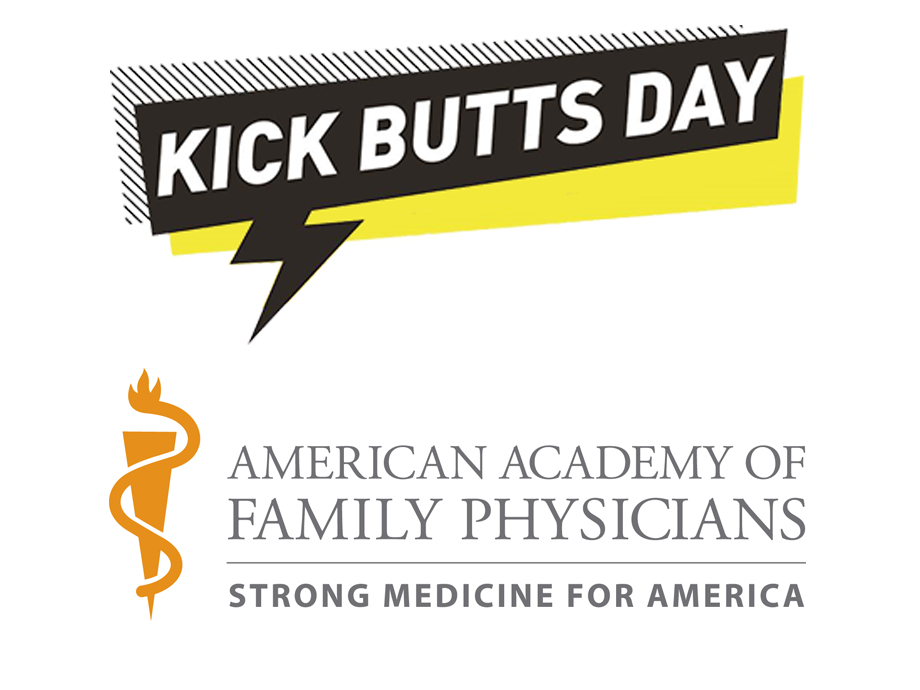AAFP Offers Resources to Support Kick Butts Day, March 21
Academy Joins Other Groups to Highlight Campaign for Tobacco-Free Kids Initiative
March 14, 2018, 01:06 pm Chris Crawford – The AAFP is joining the American Academy of Pediatrics, American College of Obstetricians and Gynecologists, and the American College of Physicians to support this year's Kick Butts Day from the Campaign for Tobacco-Free Kids on March 21.

The annual event calls on teachers, youth leaders and health advocates to raise awareness of the problem of tobacco use in their communities, encourage youth to reject tobacco industry marketing and stay tobacco-free, and advocate that elected officials act to protect kids from tobacco.
The Academy has collected its multifaceted tobacco control resources onto a special Kick Butts Day-themed webpage for family physicians to use in concert with this event.
The resources include a graphic members can use on social media on March 21 to promote Kick Butts Day. The graphic states that more than 359,000 physicians support Kick Butts Day and features the AAFP logo, along with the logos of other participating groups.
A second graphic features family physician Daron Gersch, M.D., of Albany, Minn., with a tip on talking with teens about tobacco use. Gersch is chair of the AAFP Commission on Health of the Public and Science's Subcommittee on Public Health Issues.
Story highlights
The Kick Butts Day campaign also offers family physicians and others an opportunity to explain on social media how they "kick butts" by discouraging tobacco use, particularly among youth, and urges them to use #kickbuttsday in their posts.
Extent of the Problem
According to the CDC, in 2015, cigarette and smokeless tobacco companies spent $8.9 billion on advertising and promotional expenses in the United States.
The agency detailed how tobacco companies intentionally create advertisements and sponsor events, parties, promotions and giveaways to aggressively target specific marginalized populations, including the lesbian, gay, bisexual and transgender community; African-Americans; Native Americans; and people with mental illness. This targeted marketing has contributed to higher rates of tobacco use in these populations.
Thanks to their focus on confronting health disparities, the AAFP and The EveryONE Project recognize that some marginalized populations are particularly likely to have higher rates of tobacco use and related negative health outcomes and, thus, may benefit even more from prevention and cessation programs and initiatives such as Kick Butts Day.
Advice From a Family Physician
Speaking on behalf of the AAFP's Kick Butts Day effort and the campaign's focus on keeping kids tobacco-free, Gersch told AAFP News he advises his child and adolescent patients that if they want to be the best in whatever sport, activity or career they choose, smoking won't help them achieve their goals and can, in fact, be detrimental. He also drives home the fact that smoking makes people smell bad.
"Interestingly, while I do talk with them about the health risks of smoking, I find talking about the health issues of smoking at this age to be of little effect since we are all 'immortal' at this age," Gersch said.
For patients in their 20s and 30s who've already started smoking, Gersch said he discusses the financial impact of smoking during the next 30 to 50 years of their lives.
"I get out a calculator and ask them how much they spend per day on smoking and then multiply that out to one year and then 10 years and 30 years," he said. "We talk about the fact that if they were to save that money in a separate account instead of spending it on smoking, they could have a nice retirement package."
Ironically, Gersch said he's noticed that smoking is more prevalent among his patients who are less well-educated. "Because of this, they also tend to have a lower income potential," he noted. "These are probably the very people who can afford least to be smoking in the first place."
Besides being a family physician, Gersch also is the mayor of Albany, a small town of around 2,600 people. In that role, he's been a vocal anti-tobacco advocate, especially when it comes to youth in his community.
"Unfortunately, our town does not have the financial resources to increase the smoking age from 18 to 21, unless all the cities around us did the same," he said.
Gersch suggested that family physicians in larger urban areas form grassroots coalitions to lobby their elected officials about increasing the age to buy tobacco from 18 to 21.
"In Minnesota, we have four cities that have already done this," he said. "And as more cities do it, it's only a matter of time before the entire state does."
Related AAFP News Coverage
CDC Report
Despite Known Dangers, Women Still Smoke During Pregnancy
(3/6/2018)